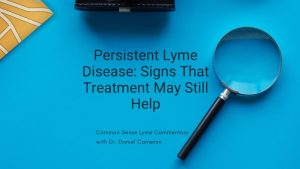Call for your appointment today 914-666-4665 | Mt. Kisco, New York

In their article, “Contrast Sensitivity Loss in Patients With Posttreatment Lyme Disease,” Rebman and colleagues report that Lyme disease can cause eye problems, specifically a loss in contrast sensitivity.¹
Contrast sensitivity (CS) is most important when the contrast between objects and their background often is reduced such as low light, fog or glare. For example, driving at night requires good contrast sensitivity for safety. “It [CS] is especially strongly associated with reading performance, ambulation mobility, driving, face recognition, and tasks of daily living,” explains Arditi.2
The Rebman study found, “CS impairment was associated with an increased odds of being in the PTLD [Posttreatment Lyme Disease] group that was 2.6 times as high as those without CS impairment.”
The authors concluded, “CS impairment in patients with PTLD is linked to signs of cognitive and neurologic impairment and may be a marker of illness severity.”¹
There are a number of studies demonstrating various types of visual changes in Lyme disease patients.
- Padula and colleagues described the case of a young woman who developed eye problems due to Lyme disease.³
“A 20-year-old woman presented for a neuro-optometric exam with complaints of headaches, asthenopia, occasional diplopia, extreme light sensitivity, dizziness and loss of balance. She reported her symptoms started about 2 years ago with day-to-day fluctuations in her symptoms.”
“Upon further questioning, the patient reported difficulty with reading and near work producing diplopia and headaches,” the authors write.
“She also reported feeling fatigued after reading along with experiencing brain fog. The patient had difficulty tolerating busy/crowded environments, which produced anxiety and a feeling of being overwhelmed. Her attention span and cognition decreased since her symptoms started, and she experienced difficulty in school.”
- Another study describes the case of a 46-year-old woman who experienced a sudden onset of bilateral vision loss and paresthesias due to Lyme disease.[4]
- And Gibaud et al. described a 9-year-old girl who presented to the emergency room complaining of headaches for several days, along with involuntary erratic fast eye movements (opsoclonus) and left peripheral facial palsy.[5] The girl’s jerky rapid eye movements due to Lyme disease resolved after antibiotic treatment.
READ MORE: Visual changes in Lyme disease
Related Articles:
Erratic rapid eye jerks in a child with Lyme disease
References:
- Contrast Sensitivity Loss in Patients With Posttreatment Lyme Disease by Alison W. Rebman; Ting Yang; John N. Aucott; Erica A. Mihm; Sheila K. West in the journal Translational Vision Science & Technology March 21. 2021
- Arditi A. Improving the design of the letter contrast sensitivity test. Invest Ophthalmol Vis Sci. Jun 2005;46(6):2225-9. doi:10.1167/iovs.04-1198
- Padula Institute of Visual Rehabilitation, “Lyme and Tick-borne Disease: Compromise of Visual Processing”, Primary Care Optometry News. Accessed July 11, 2018
- Jha P, Rodrigues Pereira SG, Thakur A, Jhaj G, Bhandari S. A Case of Optic Neuritis Secondary to Lyme Disease. Wmj. 2018;117(2):83-87.
- Gibaud M, Pauvert O, Gueden S, Durigneux J, Van Bogaert P. Opsoclonus in a child with neuroborreliosis: Case report and review of the literature. Arch Pediatr. 2019.




Poor contrast sensitivity is also associated with biotoxin illness, most often from mold growth in water damaged buildings. There is a subgroup of patients, about 25%, who genetically lack the ability to clear these toxins, even after leaving the building. Severe inflammation and immune dysregulation develop. Such patients have difficulty clearing tick borne infections, despite aggressive treatment. It is also difficult to distinguish between symptoms of ongoing Lyme disease and biotoxin illness. It is possible that some patients with PTLD are living or working in moldy environments. It is also possible that Lyme alone could cause changes in contrast sensitivity, as it also is inflammatory and affects the nervous system. A definitive test to detect on going infection would help greatly.